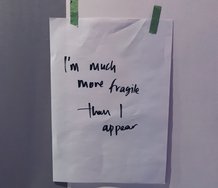Terrence Handscomb – 8 November, 2014
Despite his paper credentials and infectious charm, deep down Denny needs to grow up fast - but there is no reason for him not to. With so much support and love coming his way, failure seems quite unlikely. Dotcom's electoral politics and the public's unwillingness to separate the tabloid Dotcom from The Personal Effects of Kim Dotcom, clearly caught him off-guard.
Wellington
Simon Denny
The Personal Effects of Kim Dotcom
4 October - 19 December 2014
Michael Lett, like many art dealers, deals not so much in objects but stories; states of representation in which excess is profit and feeling is currency. In New Zealand, Peter McLeavey is the paradigm. In its heyday, you came away from Peter McLeavey Gallery with the feeling that if you hadn’t bought something, your world would be somehow empty. This often amused me but it also dismayed me, because the engagement was not so much about the thing — the object — but about the sale and an excess of representation driven by a something that is not entirely intelligible. I call this feral duplicity, which like the taste of fake sweeteners, can leave a bitter aftertaste.
So when Michael Lett, Simon Denny’s New Zealand art dealer, in Wellington for the opening of The Personal Effects of Kim Dotcom, got up at dinner and volunteered a saccharine tribute to Denny, I despaired. Always the performer, Lett is quite capable of conjuring up the deep felt positivity and enthusiasm, which is essential in his profession. To a room full of believers, his excessive flattery went down extremely well.
It’s usually impossible to separate an art dealer’s feelings from the practical efficacy of their business; and again, Peter McLeavey is the exemplar. This duplicity can be disquieting if one’s approach to art is veridical and not iconic. That evening I felt the same disquiet with The Personal Effects of Kim Dotcom, Denny’s infectious charm, his feral duplicity and what I perceived to be his well-armored soft underbelly - so it is no surprise to learn that Denny and Lett, artist and gallerist, are indeed a match made in heaven (cf. Henry Oliver, “The art of success,” Metro Magazine, November 2014, p. 62).
Despite the excitement surrounding his rise to international success — meteoric by NZ standards — Denny has many local detractors who suspect his narrative and resent his offshore success. A critical assessment of Denny’s work is easily swept aside by his energy and positivity. The excitement that his international success is generating in NZ is quickly breeding a growing number of faithful who will not tolerate disparagement. Criticality can be a killer of feel-good sentiments in art, so it didn’t help Denny’s narrative of success when Walters Prize 2014 judge Charles Esche, who in his announcement speech implied that Denny’s work was never on his list of potential winners, raised an annoying narratological inconsistency for Team Denny.
Esche’s shrewd choice of winner and the way in which AAG presented the Sao Palo Biennial curator’s top-of-the-line international credentials, exposed an anomaly in the veracity of the Denny story. Team Denny quickly turned on the judge for either getting it wrong or not properly understanding the artist’s work, such was the expectation that he would win. However the Walters Prize snub has not diminished the Denny myth. Soon after the Walters announcement, MoMA New York bought five pieces from Denny’s Walters nominated show. Denny fans gloated (cf. ibid. p. 65).
By driving a wedge between the deep critical analysis of a work of art and institutional acquisition policies, Team Denny easily trivialised Esche’s decision. However, Esche’s snub raises an important point: the difficulty any critical analysis faces against what at first appears to be a watertight case for Denny. One has to go deep beneath the hoopla if the structural flaws that exist in Denny’s process, and the crafted assertions of his own shifting narrative, are to be tested against anything more than sour grapes and the market-based merit rankings of Artfacts.net (cf. ibid p. 58).
New Zealand’s Venice Biennale 56 curator, and fervent Denny fan, Robert Leonard is quick to explain away suspicions of and resistance to Denny’s work as the failure of his critics to recognise that the Denny phenomenon constitutes one of those “…breakthrough moments, when things are so new that, at first, people fail to understand them as art” … “I think of Manet’s Olympia or Duchamp’s Fountain. Denny is doing something similar” (ibid. p. 60). Clearly Leonard’s silly exaggerations, replete with recognisable imagery, are aimed at a local audience who he insinuates, are not yet up to speed with the Denny phenomenon. Even if this is true, his words entail the patronising assumption that if one is slow to recognize the genius of Denny’s work, then it is because one’s own judgements are flawed, not the thing being judged.
As I see it, “breakthrough moments” — in keeping with current philosophical thinking, call them singularities, singular moments or simply ‘events’ — are always disruptive in effect and revolutionary in character. Singular events in art, when they occur, collapse the gap between the simple presentation of things — the art objects — and the excesses of the representations which in art give them meaning and gives cultural weight to their pecuniary value. When actual breakthroughs occur — not the fake ‘events’ and ‘breakthrough moments’ Leonard is talking about — existing states of representation collapse and it takes the mutant logic of a genius to pull meaning out of the symbolic meltdown that inevitably follows. When actual events occur, no one knows what the hell is going on.
Denny’s process is plain-out too tailored to instigate an event. He is just not into revolution. Denny has yet to meltdown or allow his careful branding to blow apart. His brand favors seduction over destruction and accessibility over obfuscation (ibid. p. 59). Denny’s interest in the idea of disruption-as-unproductive-failure, is motivated by his reading of New Yorker journalist Jill Lepore’s critique of the economic theory of disruptive innovation, first introduced by Harvard economics scholar Clayton Christensen and his groundbreaking 1997 book The Innovator’s Dilemma (the title of which Denny arrogated for his own City Gallery, Wellington talk). “Disruptive innovation is an economic theory about why businesses fail” and “the rhetoric of disruption [is] a language of panic, fear, asymmetry, and disruption … in which an upstart [company] refuses to play by the established rules of engagement” [1]. Therefore, the innovator’s dilemma — “doing the right thing is the wrong thing” — occurs when companies fail not because their executives made bad decisions, but because they continue to make good decisions.
In her critique of Christensen, Lepore notes that in the last fifteen years the mantra of disruptive innovation has morphed into the principle of wilful destruction. Corporations sack their principals who represent the unproductive old ways and bring on smart young innovators who, it is hoped, will re-float a sinking ship. This, Lepore argues, never works. The usual outcome is unproductive destruction without restorative innovation.
Denny is of a new generation of artists, who always with their audiences in mind, have distanced themselves from the disruptive and unproductive character of a dated ‘avant-garde’ (ibid. p. 59). Ironically, his abhorrence of a disruptive and unproductive avant-garde — a post-object solution to The Personal Effects of Kim Dotcom would be to simply pin the list of Dotcom’s confiscated possessions to the gallery wall, but Denny clearly loves a production — now entails its own dilemma, caused by the unexpected and disruptive foray by the actual Kim Dotcom into NZ electoral politics, its consequential affect on the public reception of The Personal Effects of Kim Dotcom and Denny’s urgent scurry to distance himself from it all.
Powerful ideas like disruptive innovation could have allowed the installation to take on an incisive new meaning. When it comes to narrative control, Denny is a control freak and Dotcom’s clumsy public manipulations of NZ politics does not, it seems, suit the Denny brand with its suave seductions and corporate aesthetic.
Ironically, Dotcom’s disruptions could have worked for Denny, but he avoided it, choosing instead to retreat to the safer ground of artist’s intentions, which are not at all clear, but which seem to have something to do with sourcing the “logic that functions on the internet” (whatever that means) [2], exploring the legal ramifications of intellectual property, illegal file swapping and the forced closing of Dotcom’s file-sharing site Megaupload — which Denny, when living in Berlin, used to illegally (one supposes) download English language movies and TV programs ohne deutsche Synchronisation und englische Untertitel.
Kim Dotcom’s unexpected, but quite comical, foray into NZ electoral politics, was never on Denny’s narratological radar. With the protective instincts of an angry lieutenant, an ardent member of Team Lett, when he heard that I may “review” the show, took it upon himself to set me straight on the fidelity of Denny’s intentions and how these were not to be associated with the Dotcom public fiasco, which incidentally, everyone was talking about at the opening. When a work is in the public domain, its meaning is up for grabs and semiotic control is no longer in the hands of the artist. An understanding of a work may indeed include the artist’s intentions, which are usually mutable and Denny’s intentions seem to change to suit the context. At best artist’s intentions should be considered as analytical pointers, if our understanding of art is to be informed by anything more than sour grapes and the protective hype of art dealers.
Being tabloid-bait to us commoners, the actual Dotcom is indeed now part of The Personal Effects of Kim Dotcom, whether Denny likes it or not. When engaging with the installation we cannot help but voyeuristically gaze into Dotcom’s life with a tabloid interest that cannot be undone. The fidelity of the artist’s intentions is easily slurried. Trying to stick narrative to object is difficult and Denny too easily believes representation is the object, which means that when the narrative gets out of control, all hell can break loose in the mind of an artist.
By capitalising on the Adam’s decision to time the show to coincide with the NZ elections, Denny could have used one of his narrative catchphrase fillers as actual motivation: disruptive innovation could have worked for him. With deft pliability he could have turned everything around and used the associative tension between unforeseen disruption and the stability of a finished work, then quietly let the willing pass it off as artist’s prescience (some punters at the dinner claimed such prescience, which they allege was entirely due to Denny’s artistic genius). Trapped by his own conceptual arrogations, feral duplicity failed him. Instead of running with it, he ran from it, distancing himself from Dotcom’s ultra-left toxicity to such extent as to apprehensively announce that he would not show the work again: destruction without innovation!
Despite his paper credentials and infectious charm, deep down Denny needs to grow up fast - but there is no reason for him not to. With so much support and love coming his way, failure seems quite unlikely. Dotcom’s electoral politics and the public’s unwillingness to separate the tabloid Dotcom from The Personal Effects of Kim Dotcom, clearly caught him off-guard — and his disappointing reaction to it is telling. Denny will carefully regroup for Venice and prepare for the ever-shifting political quicksands that surround Edward Snowden — government surveillance and Snowden’s NSA leaks is the latest rumored theme for Denny’s Venice project, but this could change. He will however, need to be vigilant on a number of fronts. Snowden politics can be messy and with his inexperience Denny may unwittingly overreach. By co-opting Nicky Hager into the fold, a number of moneyed punters are, already conspicuously distancing themselves from his Venice project. However, Denny is the consummate salesman and he tends to surround himself with good people. With charm and positivity he easily wins individuals over and his work is easy to understand. People like that.
Even though the New Zealand arts community has a history of abandoning its anointed young, especially when they reach a certain age — Binney, Killeen, Robinson — Denny will probably break the mould because he got out early and much of his local support comes with the warm winds of success, which down under, still blow onshore.
1. Jill Lepore, “The Disruption Machine: What the gospel of innovation gets wrong,” New Yorker, June 23, 2014. See also Christensen’s response in “Clayton Christensen Responds to New Yorker Takedown of ‘Disruptive Innovation,’” Bloomberg Businessweek, June 20, 2014)
2. Home page, Adam Art Gallery, http://www.adamartgallery.org.nz; downloaded: 31 October 2014 4:45 PM.
Terrence Handscomb
Recent Comments
Terrence Handscomb
Two belated comments: I find no problem in minimizing the theoretical language in the essay. Because the philosophical underpinning of ...
Ralph Paine
Thank you Mr Fenney. Yes, artists do seek and create direct discourse. But alongside and interlocked with that, today the ...
Ralph Paine
Mr Feeney does not claim that art-in-general (or an art) gathers its status and relevance from context, what he’s saying ...

 Advertising in this column
Advertising in this column Two Rooms presents a program of residencies and projects
Two Rooms presents a program of residencies and projects



This Discussion has 10 comments.
Comment
Ralph Paine, 2:31 p.m. 10 November, 2014 #
Politics without the Revolution? More like Politics without the Politics.
I’d rather go to the electronics shop at the f_cking mall than visit any Simon Denny exhibition. Or stay home all afternoon watching back-to-back episodes of American Dad on the BIG SCREEN TV. Or lie in some forest listening to ULTRAVIOLENCE playing on my new i-Pod, real real loud in the sleek white headphones. Or…
Come on Mr Handscomb, precisely which team are you on? You and I could b_tch on in public forever about scenes ‘n’ trends. Yeah, we know the players. We’ve been to the dinners, made the applications, studied the manuscripts, fixated in great hallucinatory detail on the weirdly shifting sands of our times. But no need now to get all Fatherly on it, concern-driven and advice giving—that just throws you back into the camp of the THEY, back into the earnest wanna-be Prada model careerism crowd, back into a certain contemporary art world hell.
Terrence Handscomb, 11:05 a.m. 14 November, 2014 #
WOW! … you did that in under 200 words. My work is done …
Luke Munn, 10:12 a.m. 13 November, 2014 #
It's ironic that this article laments the lack of 'critical assessment of the work' then quickly descends into personal attacks, anecdotes, hypothetical musings, and dripping sarcasm. Instead of a close analysis (or indeed any description at all) of the work, which would be welcomed, this reads more like a series of ad hominem attacks with an us vs them approach, ('commoners' and 'Team Denny', really?). Disappointing.
Ralph Paine, 2:14 p.m. 14 November, 2014 #
Mr Handscomb doesn’t complain of any lack of critical analysis, what he’s saying is that when art is presented AS critical analysis what results is an over-determined (& thus over-determining) situation. This is why he accuses Team Denny of being control freaks, and he’s 100% correct. The exhibition, the career, the projected trajectory of reception… Everything is pre-saturated with an excess of meaning. In other words, we find ourselves in circumstances where redundancy rules: there’s too much sense and not enough non-sense; too much signal and not enough noise.
So yeah, and despite Mr Leonard’s lost-the-plot claims, there’s nothing radically new going on here. In fact, this is the NORM; this is how collective assemblages operate; this is the language-function as indirect discourse: ‘the presence of a reported statement within the reporting statement, the presence of an ORDER-WORD within the word’ (D&G). In this sense, language ‘is made not to be believed but to be obeyed, and to compel obedience.’ Hence: language is not informational and communicational. And further, ‘the order-word is redundancy even when it is in rupture with a particular semiotic,’ and thus disruption ought to be understood as simply another aspect of BUSINESS-AS-USUAL.
No, artists do not seek or create disruption. What artists seek or create is DIRECT DISCOURSE. They want to discover the PASS-WORD beneath the order-word, to extract an autonomous Self from behind the subjected I—they want to speak in tongues. And they do this by detaching things, signs, fragments, words, etc. from the given collective assemblage, from all apparent social determination, and re-presenting them as radically xenoglossic beings. As Mr Handscomb kinda points out, Team Denny botches the art for the sake of the collective assemblage... Art=Utility.
Terrence Handscomb, 11:02 a.m. 14 November, 2014 #
Despite imputing meaning and intention where there is none -- neither “lament” nor its cognates appear anywhere in the text -- you have raised some good points that deserve discussion, if not clarification.
I don’t find Denny’s body of work particularly interesting, nor am I motivated enough, to write “A critical assessment of Denny’s work.” Alice Tappenden has written an excellent ‘assessment’ of Denny’s Adam show for EC. Besides, I find the work of other NZ artists much more engaging -- currently Kalisolaite 'Uhila and Luke Willis Thompson, for example. What I am interested in, and this is really the guts of my essay, is the Denny phenomenon, the narrative of his rising fame, and its populist manifestation fired-up by the Nov. issue of “Metro.” Whether you like it or not, “Denny” has become a state of representation that is utterly pro hominum. As far as I am concerned, this hominum-ity is the meaning of his Adam show and not the expected engagement with its materiality nor its intentionality.
By the time “The Personal Effects of Kim Dotcom” made it to our shores, the sculptural things that he made and the objects he presented -- what I suspect you would call the ‘art’ -- had been entirely eclipsed by the excesses of Denny’s mythology; the intensity of which is entirely new for NZ. Furthermore, the intended meaning of the show was hilariously eclipsed by the tabloid representations of Kim Dotcom, which by the time of the opening, had been all over the media. Interestingly, the objects that form TPEOKD were already states of representation.
If there is any lament entailed by all this, then it is a complex philosophical one: the ontological congruence of presentation and representation is indiscernible. This intrigues me.
‘Commoners’ and ‘Team Denny’ are throwaway insults -- get over it!
Warren Feeney, 8:17 p.m. 14 November, 2014 #
It is interesting that there are criticisms leveled here at Handscomb for his 'failure' to talk about the work. Really? I felt he was talking about the work - not the detail of its processes or ideologies but its context - which is where its status and relevance resides. Claims about Denny's 'hypothetical musings and dripping sarcasm' I read as being about the context of his practice rather than dealing with the small detail of his work. One of the unfortunate aspects of the 'professionalisation' of the arts in NZ from the late 1970s on, has been the unquestioning commitment to the notion that when it comes to serious art - context is everything. Hence, Ralph Paine's commentary about artists wishing for direct discourse with audiences is equally pertinent and greatly appreciated. (I can't quite believe I said that - but I do mean it).
Ralph Paine, 6:02 p.m. 16 November, 2014 #
Thank you Mr Fenney.
Yes, artists do seek and create direct discourse. But alongside and interlocked with that, today the context of art and the context of everything else is radically changing, has already changed. And I'm not talking about the Internet. No, the new context is named the Anthropocene...
Luke Munn, 10:49 a.m. 15 November, 2014 #
Appreciate the comments guys, a brief response...
I wouldn't go so far as to say that context is where the totality of an arts status and relevance reside, but rather in the interplay between process, production, artist, audience, social and cultural contexts and other factors. So yes context is important, but equally it seems highly subjective, particularly in the way that Terrence is approaching it, by referencing a private dinner, other artists he prefers, and speculating on future moves and motivations (venice). In my opinion, there's likely a significant disparity between his context and the Adam audience's context. The editorializing style and loaded language didn't help. Terrence, you make some good points about mythology, intentions and representation but these points were made much better in your dialed down comments, imho. ;-)
Ralph Paine, 5:23 p.m. 16 November, 2014 #
Mr Feeney does not claim that art-in-general (or an art) gathers its status and relevance from context, what he’s saying is that the exhibition 'The Personal Effects of Kim Dotcom' gathers ITS status and relevance from context. Or even that the exhibition is its context, that it's set up precisely as a critical analysis of "the interplay between process, production, artist, audience, social and cultural contexts and other factors" (to use your words). If we were living in 1914, or even 1974, this kind of artistic set up might be noteworthy. Today the result is boringly repetitive, nullifying, productive only of an infinitely regressing form of self- and collective conciousness. Productive, then, of what Hegel called a Bad Infinity.
The classic text here is Brian O'Doherty's 'Inside the White Cube: The Ideology of the Gallery Space', first published in 1976, and republished in 1976 with an introduction by Thomas McEvilley. Here's the first sentence of McEvilley's intro: "It has been the special genius of our century [the 20th] to investigate things in relation to their context, to come to see the context as formative on the thing, and, finally, to see the context as a thing in itself." O'Doherty's follow up text 'Studio and Cube: On the Relationship Between Where Art is Made and Where Art is Displayed' was published in 2007.
It's interesting to note that in contemporary philosophy there are debates raging about the relative importance of the thing versus the context, or the object versus its condition of possibility.
Terrence Handscomb, 1:48 p.m. 24 November, 2014 #
Two belated comments: I find no problem in minimizing the theoretical language in the essay. Because the philosophical underpinning of the text is not labored, it doesn’t follow that its style and content are not informed by one.
The ‘editorial’ style, as you put it, resembles Metro’s journalese which, whether we like it or not, is a significant carrier of the Denny myth. My critique of the myth, simply matches Metro’s style without voicing it’s flattery.
One should never underestimate the efficacy of style in the act of provocation.
The argument from context was not the theoretical template for my essay, although this has been plausibly inferred and well discussed above. My theoretical template was a hybrid reading of recent ontologies rather than 1980s semiotics and it engages a different vocabulary: situation, site, event -- whose philosophical pedigree should be familiar.
In this respect, ‘his [my] context,’ the “private” dinner contex and perhaps even ‘the Adam audience’s context’ are better seen as disjoint parts of the same situation; the NZ art world. In this situation, each ‘context,’ if you like, constitutes opposing excesses that become volatile when their mutually disjoint elements are forced to occupy the same linguistic zone. ‘Forcing’ the collapse of representational excess is one of the principle mechanisms of Badiou’s theory of the event.
Participate
Register to Participate.
Sign in
Sign in to an existing account.